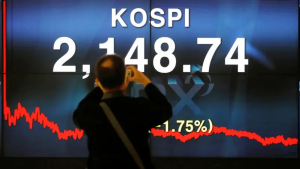As the Bank of Canada considers ditching oversized interest rate hikes, it is dealing with an economy likely more overheated than previously thought but also the bond market's clearest signal yet that recession and lower inflation lie ahead.
Canada's central bank says that the economy needs to slow from overheated levels in order to ease inflation. If its tightening campaign overshoots to achieve that objective it could trigger a deeper downturn than expected.
The bond market could be flagging that risk. The yield on the Canadian 10-year government bond has fallen nearly 100 basis points below the 2-year yield, marking the biggest inversion of Canada's yield curve in Refinitiv data going back to 1994 and deeper than the U.S. Treasury yield curve inversion.
Some analysts see curve inversions as predictors of recessions. Canada's economy is likely to be particularly sensitive to higher rates after Canadians borrowed heavily during the COVID-19 pandemic to participate in a red-hot housing market.
The BoC has opened the door to slowing the pace of rate increases to a quarter of a percentage point following multiple oversized hikes in recent months that lifted the benchmark rate to 3.75%, its highest since 2008.
Money markets are betting on a 25-basis-point increase when the bank meets to set policy on Wednesday, but a slim majority of economists in a Reuters poll expect a larger move. Canada's employment report for November showed that the labour market remains tight, while gross domestic product grew at an annualized rate of 2.9% in the third quarter.
That's much stronger than the 1.5% pace forecast by the BoC and together with upward revisions to historical growth could indicate that demand has moved further ahead of supply, economists say.
But they also say that the details of the third-quarter GDP data, including a contraction in domestic demand, and a preliminary report showing no growth in October are signs that higher borrowing costs have begun to impact activity.
The BoC has forecast that growth would stall from the fourth quarter of this year through the middle of 2023.
The depth of Canada's curve inversion is signaling a "bad recession" not a mild one, said David Rosenberg, chief economist & strategist at Rosenberg Research.
It reflects greater risk to the outlook in Canada than the United States due to "a more inflated residential real estate market and consumer debt bubble," Rosenberg said.
Inflation is likely to be more persistent after it spread from goods prices to services and wages, where higher costs can become more entrenched. Still, 3-month measures of underlying inflation that are closely watched by the BoC - CPI-median and CPI-trim - show price pressures easing.
They fell to an average of 2.75% in October, according to estimates by Stephen Brown, senior Canada economist at Capital Economics. That's well below more commonly used 12-month rates.
"The yield curve would not invert to this extent unless investors also believed that inflation will drop back down toward the Bank's target," said Brown.
"The curve is telling us the Bank of Canada will be forced into a reversal by late 2023, with rates remaining depressed for years to come," Corpay's Schamotta said.











